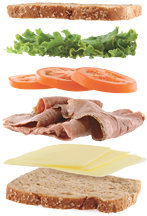 |
 |
|
|
Health Articles:
Alternative and General Health
Musculoskeletal Health
Nutrition and Herbs
Pediatric Health
Senior Health
Sports & Fitness
Women's Health
Ask A Doctor (Forum)
|
continued...
Healthy Sides One of the side dishes we need to encourage kids to enjoy is green vegetables (snap peas, broccoli, zucchini slices, etc). Don't forget to expand the color spectrum (squash, red and yellow bell peppers) to include the antioxidant family. Introduce a healthy dip like hummus. You can also find healthy vegetable-based dips in whole/health food stores and major chain stores. Fruit is also a great side dish, but try to avoid fruit cups and processed roll-ups. Your child's lunch will be much healthier if it includes sliced or chopped organic fruit topped with shredded coconut, raisins or raw nuts instead of processed snacks. Consider putting together a grain salad - for example, couscous or steamed, long-grain brown rice with chopped cucumbers, red peppers, baby carrots or a similar vegetable. Marinate the chopped vegetables in a salad dressing for a few days prior to preparing the salad. Drain the vegetables and then mix them in. This will add moisture to the salad, reducing the need to add excess dressing. Create a Menu Your children know better than you do what they're going to want for lunch, so it's important to let them participate actively in the selection and preparation of their lunches. When children are included in the process, they are more likely to finish what they started. As a parent, where do you begin? Start by committing to only healthy lunch choices. This might involve spending a few hours with your children at a bookstore or library, or searching on the Web. What are you looking for? Cookbooks and other resources that focus on whole/natural menus for kids. Then develop a planning board so your children can mix-and-match their lunch menu for the week. Using a white board, poster board or something similar, draw out five columns and label them for each day of the week. Using color-coded Post-It notes, index cards or colored paper, create a square for each lunch option. For example, put protein options on blue cards/paper, vegetable options on green, fruits on yellow and snacks on pink. Each weekend, let your children select from each of the food cards and build a five-day lunch menu for the upcoming school week. Remember that while this is being done, the entire family can begin preparing and prepackaging some of the choices that can be frozen or stored for a few days. When Monday rolls around, you'll be ready to go with healthy options for your kids' lunches! You Are the Teacher It's important to remember you have to be your child's advocate when it comes to eating healthier lunches. If we let this meal go to the "waste side," we are not only losing another opportunity for children to grow up healthy with the necessary building blocks, but also missing the opportunity to teach them that each meal counts and can have great taste appeal.
Claudia Anrig, DC, practices in Fresno, Calif., and is on the board of directors of the International Chiropractic Pediatric Association, an organization that can answer your questions regarding the value of chiropractic care during and after pregnancy.  |
|||
